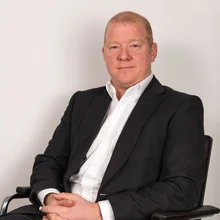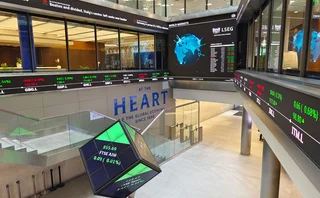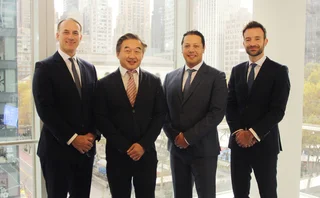
Currency derivatives house of the year: Deutsche Bank
Risk Awards 2018: Search for forex market’s gaps spurs huge growth in correlation trades and new tech services

As foreign exchange trading has become more electronic, and the products more standardised, dealers have had to confront a fundamental problem: how to make money. That problem was magnified in this year’s monotone markets.
Deutsche Bank’s answer is to branch out.
“From a markets perspective it’s been a quiet, challenging year across the Street,” says Jonathan Tinker, co-head of forex at Deutsche Bank. “Our strategy over the last couple of years has been all the more important given the environment we find ourselves in this year, which is to pivot away from pure execution and try to offer a broader range of services.”
Those services are an attempt to occupy distinct territory; gaps in the market where Deutsche faces less competition and where, put bluntly, it can earn more money. The gaps range from more complex derivatives such as correlation products – where idea generation and risk management is more important than price – to new technology, so clients can roll their hedges automatically or execute contracts like structured forwards electronically.
What unites them all is that Deutsche might only be competing against three or four other banks in each, says Tinker. More vanilla areas of the forex derivatives market, such as one-month options on EUR/USD, have become overcrowded.
“Just about everybody on the planet quotes that,” he says. “The ability to provide prices is becoming ubiquitous across the market, and so the difference in a lot of areas between best price and tenth best price is often not very much. That is certainly the case compared to being able to give people additional services that potentially reduce their operational risk or increase their efficiency in some way.”
A prime example is Maestro, a pre-trade platform accessible via the bank’s hugely successful Autobahn platform – its multi-asset electronic service. It helps minimise operational risk by re-routing a bundle of daily, manual processes through a single platform.
“A lot of these flows just need to be done in whatever way is most transparent, efficient, straight-through, and at the lowest total cost,” says Yannick Marchal, head of forex workflow solutions at Deutsche Bank.
We’re expecting the next stage to move into payments. We’ll try to make that process smooth for corporates that deal with thousands of accounts, distributors, payables and receivables
Yannick Marchal, Deutsche Bank
Calculating and checking share-class spots and hedge adjustments for multiple funds might take several hours, but can be reduced to seconds when using Maestro. As a result, the platform has been rapidly adopted. Since 2015, Maestro has seen the number of orders processed increase by 625%, from 20,000 to 145,000 year-to-date.
A lot of the use of Maestro is coming from those firms that do not traditionally trade forex, but still need to hedge positions as part of an equities share-class trading strategy, or a corporate looking to hedge the currency risk it takes on when exporting goods. This can be manual and clumsy.
“At the moment, a lot of trade determination is just people using spreadsheets. For example, in a share-class hedge for a small asset manager, getting all the right information to determine the trade would mean going to an operations person, taking up the time of the trading team, relying on reports from transfer agents for subscriptions and redemptions, a report of current forex hedges, and a net asset value report from the fund accountant, which are all on different systems,” says Marchal.
Customers like it. Michael Surridge, chief executive at KIS Capital Partners, runs a multi-currency class equity long/short fund, and uses Maestro when rolling forwards to manage its currency exposure.
“The service is very transparent on pricing with defined spreads and costs to independent fixing levels for spots and forwards. It’s also designed to support the customer – the forwards roll automatically to the correct future date even if we forget to do so, and we are sent a reminder prior to the roll,” he says.
The development of Maestro has not happened overnight. The work began five years ago, taking a tool that was being used within the bank and expanding its capabilities. Now Deutsche is eyeing the payments sector.

The more confidence you have in your systems and ability to see tail risks and bad scenarios, the better equipped you are to take down more risk and give tighter prices
Jonathan Tinker, Deutsche Bank
“We’re expecting the next stage to move into payments,” says Marchal. “We’ll try to make that process smooth for corporates that deal with thousands of accounts, distributors, payables and receivables. We have a platform for straightforward flows, but now we want to be able to pre-process a lot of data, mould together the forward hedges, swap execution pricing, and outbound payments into an entirely holistic solution.”
The push into less crowded areas is also the view the bank has taken for execution services. Over the past few years, Deutsche has developed an electronic version of its structured forwards offering, dubbed AOS, which is also used within its own sales team.
The electronic offer attracts private banks, which want to use the platform themselves to price products that can have dozens of inputs, and to monitor their portfolio – it also makes it easier for salespeople to cover corporate clients.
“A private bank might have hundreds of structured forwards on, so having a unified place to look at their portfolio with Deutsche Bank and summaries of a complex product is far easier electronically compared to voice,” says Julien Vinit, head of forex quants at Deutsche Bank. “As a result, AOS has helped us engage with those private banks.”
For corporates and others, the automatic execution, booking and hedging of these products via AOS has helped the bank provide tighter prices on smaller trades, as well as speeding up the price formation to just a few seconds, when it could take hours over email.
Being able to offer large capacity in an underserviced product is a very valuable service
Jonathan Tinker, Deutsche Bank
The result has been a doubling of notional volumes executed on AOS in the past 12 months.
“Showing tight prices in large size is more as a result of the breadth of your franchise, while tight prices in small size is linked more to how automated your processes are. Small trades could easily not be profitable if you don’t have the automated processes to deal with them, but AOS allows us to do that,” says Vinit.
Technology also underpins Deutsche’s strength in forex correlation products – which come in a variety of forms but all involve payoffs that reference two or more currency pairs. A revamp of the bank’s risk management platform, Autoblotter, means it now has more confidence when pricing these products and other complex trades.
“We can see real, live risk across a wide range of scenarios and a combination of books and positions. The more confidence you have in your systems and ability to see tail risks and bad scenarios, the better equipped you are to take down more risk and give tighter prices,” says Tinker.
More correlation
In correlation products specifically, Deutsche estimates the volume of clients, requests and trades it sees has roughly tripled over the past five years.
More recently, the trades have also tended to cluster around specific events – elections, most obviously – which magnifies the risk management challenge.
“The focus on events has made doing exotic options comparatively more difficult,” says Tinker. “Events have really become a focus of our customer base over the last few years, as people are less interested in generic contracts but more date-specific, strike-specific ones. There is a lot more scope for concentration risk than there used to be, as more vol is being compressed into those events.”
A good example was the French presidential election, which could have opened the door to the country’s retreat from the European Union, with serious implications for global stability.
“The main theme was to seek to hedge or benefit in the case of the election result leading to a large move lower in EUR/USD and a corresponding move in some other risk-sensitive currencies – for example, strengthening Japanese yen, weakening Australian dollar or strengthening gold,” says Logan Campbell, managing director and head of foreign exchange derivatives with the bank in London.
Because those pairs would not typically move together, the correlation product was a far cheaper way to take a position than via a simpler EUR/USD trade, he says.
“The outcome of the election actually ended up being different to the previous view that France’s place in Europe might be undermined or challenged due to the elections. Despite this, clients that had expressed their view with correlation products had likely invested less money than they might have if they had used single-currency pair trades. This is why correlation products are popular,” Campbell adds.
Capacity for hedge funds
The scale of Deutsche Bank’s franchise – it remains the second largest G-10 forex dealer by revenue globally, according to data from Coalition – means the bank can find liquidity in more esoteric currency crosses and recycle and find ways out of the risk on its books, in turn giving large capacity for hedge funds, which is predominantly what they look for, says Tinker.
“There are a relatively small number of dealers that can deliver that content and pay-off. Certain banks are good at certain things, and all of the areas where customers don’t have many places to go to find a price, we’re there. Hedge funds are searching for capacity usually and when they do a trade the challenge is to get it on in the size they desire. Being able to offer large capacity in an underserviced product is a very valuable service to them,” he adds.
Only users who have a paid subscription or are part of a corporate subscription are able to print or copy content.
To access these options, along with all other subscription benefits, please contact info@risk.net or view our subscription options here: http://subscriptions.risk.net/subscribe
You are currently unable to print this content. Please contact info@risk.net to find out more.
You are currently unable to copy this content. Please contact info@risk.net to find out more.
Copyright Infopro Digital Limited. All rights reserved.
As outlined in our terms and conditions, https://www.infopro-digital.com/terms-and-conditions/subscriptions/ (point 2.4), printing is limited to a single copy.
If you would like to purchase additional rights please email info@risk.net
Copyright Infopro Digital Limited. All rights reserved.
You may share this content using our article tools. As outlined in our terms and conditions, https://www.infopro-digital.com/terms-and-conditions/subscriptions/ (clause 2.4), an Authorised User may only make one copy of the materials for their own personal use. You must also comply with the restrictions in clause 2.5.
If you would like to purchase additional rights please email info@risk.net
More on Awards
Clearing house of the year: LCH
Risk Awards 2025: LCH outshines rivals in its commitment to innovation and co-operation with clearing members
Best use of machine learning/AI: CompatibL
CompatibL’s groundbreaking use of LLMs for automated trade entry earned the Best use of machine learning/AI award at the 2025 Risk Markets Technology Awards, redefining speed and reliability in what-if analytics
Markets Technology Awards 2025 winners’ review
Vendors jockeying for position in this year’s MTAs, as banks and regulators take aim at counterparty blind spots
Equity derivatives house of the year: Bank of America
Risk Awards 2025: Bank gains plaudits – and profits – with enhanced product range, including new variants of short-vol structures and equity dispersion
Law firm of the year: Linklaters
Risk Awards 2025: Law firm’s work helped buttress markets for credit derivatives, clearing and digital assets
Derivatives house of the year: UBS
Risk Awards 2025: Mega-merger expected to add $1 billion to markets revenues, via 30 integration projects
Interest rate derivatives house of the year: JP Morgan
Risk Awards 2025: Steepener hedges and Spire novations helped clients navigate shifting rates regime
Currency derivatives house of the year: UBS
Risk Awards 2025: Access to wealth management client base helped Swiss bank to recycle volatility and provide accurate pricing for a range of FX structures







